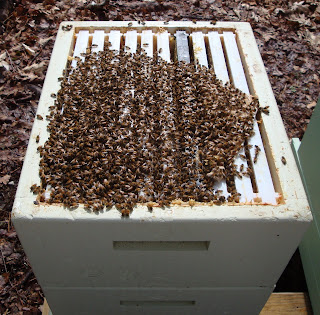First, a tip for this posting and then what we found in the order of inspection.
 Tip:
Tip:It's really exciting to see the bees making supers full of honey (fig 1), especially as a new beekeeper, but you have to remember it's their food, not yours. It's bad hive management to take the honey the bees will need for winter and then try to make it up by feeding syrup. Syrup is best used to start a package or for emergency purposes only. It is not as nutritional as the honey the bees make from nectar and recent studies in Sweden have shown syrup actually changes the pH of the bee's honey stomach from 4 to 6. I have been told that is the same pH you would use in a lab to grow Nosema ceranae. When the bees have already produced enough honey to support themselves for winter, why risk loosing a hive just so you can have a bit of honey? Make sure you leave 2 deeps or 3 mediums full of bees, pollen and honey as we enter the cold months.
 Nuc Inspection: Small cell, deep and medium wooden supers
Nuc Inspection: Small cell, deep and medium wooden supersThe bees did their job (after killing the queen I gave them) and have raised a beautiful dark queen of their own (fig 2). She has been busy and has a laid a nice center pattern on both sides of a frame with the bees packing pollen and honey around the brood (fig 3). The bees are barely starting to draw out the wood and small cell wax frames in the top medium. They will get going now that they have a queen who will need some room. Figure 4 is a shot of her actually laying an egg.
Hive 4: Large cell, deep and a medium BeeMax supers
Last inspection revealed 23 emergency cells. This time all of the cells are empty with most having been removed by the workers. No eggs or brood were yet present but the timing is right for the new queen to be out on her mating flight. I absolutely expect to find the signs of her return when we next open the hives on Sep 3rd. If she is anything like her mother, this will be a very productive hive.
 Hive 3: Small cell, deep and medium wooden supers
Hive 3: Small cell, deep and medium wooden supersThis hive, like the nuc, was a split from Hive 2 and was immediately requeened with one of Mike Palmer's Northern Hybrid queens. A very quick look at this hive showed the bees have drawn out the center frames of the medium, making a very bright yellow comb (fig 5). The queen has started laying in the medium. I will probably add another medium in September and give this hive some of the honey from hives 1 and/or 2.
 Hive 2: Small cell, 2 deep and 3 medium BeeMax supers. Queen excluder on top of 2nd deep
Hive 2: Small cell, 2 deep and 3 medium BeeMax supers. Queen excluder on top of 2nd deepThis hive went queenless and has also raised a new matriarch who is laying in the 2nd deep. There are numerous drone cells but also several frames of worker brood. My first thought was I have a laying worker but the normal brood has me hopeful. The great part of this inspection was there are zero, nunca, nada, the null set, of Varroa in any of the drone cells, and I checked over 20 of them! The bottom deep was packed with pollen and honey on 8 frames but they still have not touched 2 of the Piercos in the bottom deep. I moved them to the center to see if that will help.
 Actually, after inspecting the pictures Gayla took, I did not find any mites in any of the hive pictures. With 2 of the hives and the nuc requeening, we broke the mites' breeding cycle and have momentarily conquered the mite problem. Even queen-right Hive 3 looked clean!
Actually, after inspecting the pictures Gayla took, I did not find any mites in any of the hive pictures. With 2 of the hives and the nuc requeening, we broke the mites' breeding cycle and have momentarily conquered the mite problem. Even queen-right Hive 3 looked clean!Due to incoming weather, we never opened Hive 1. Our next inspection is Sep 3 with Ross Conrad leading a class in our apiary! Life is good...


































